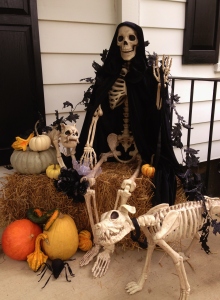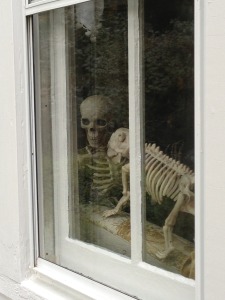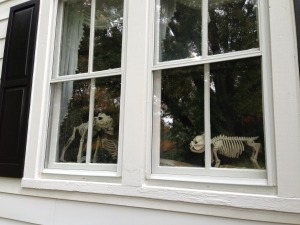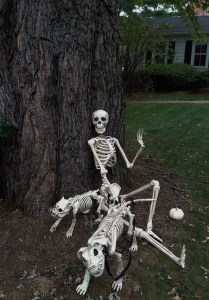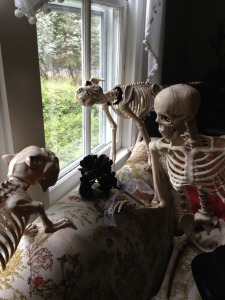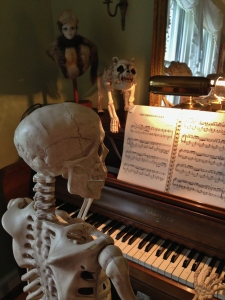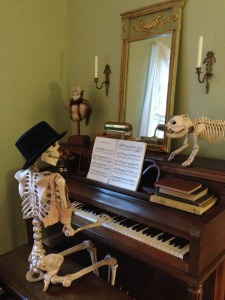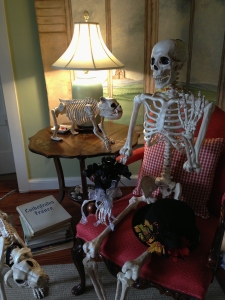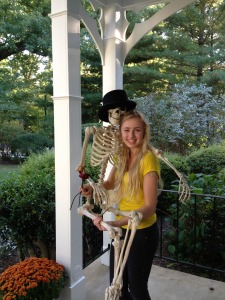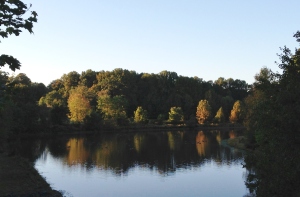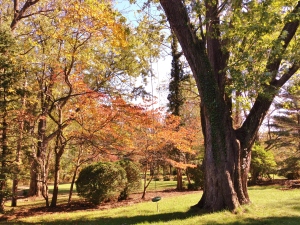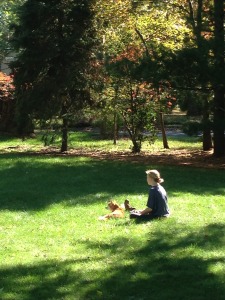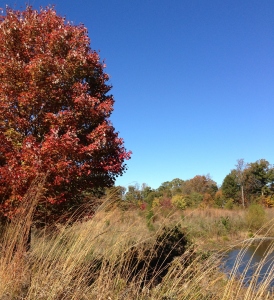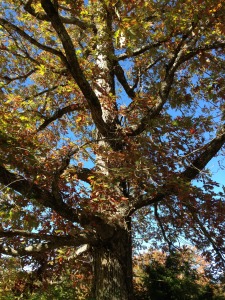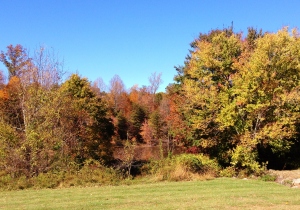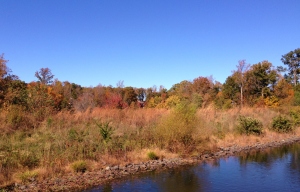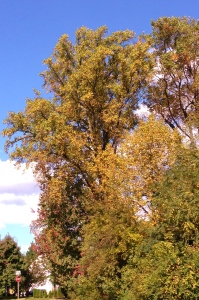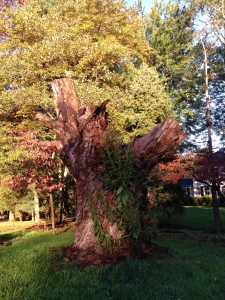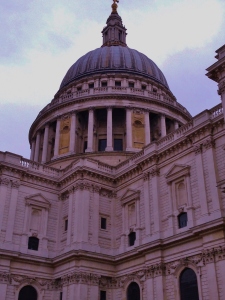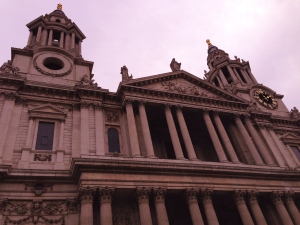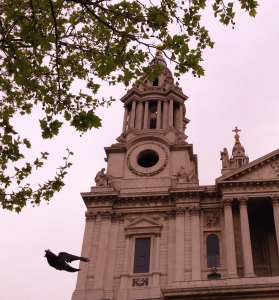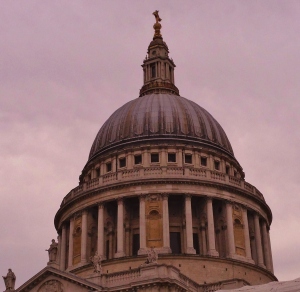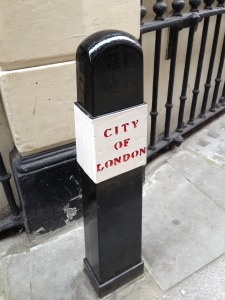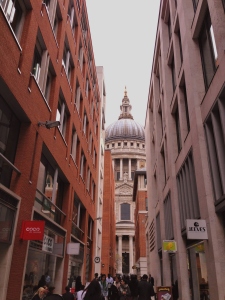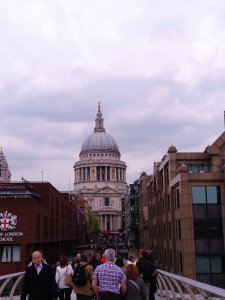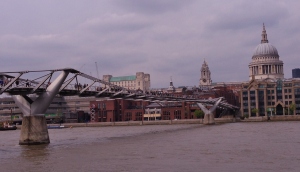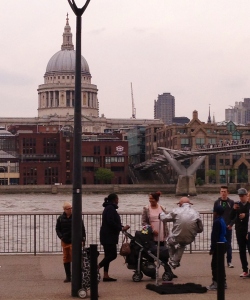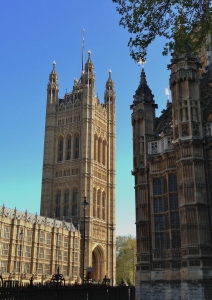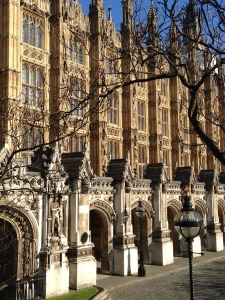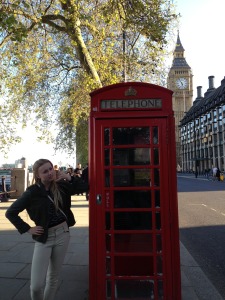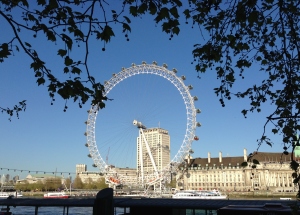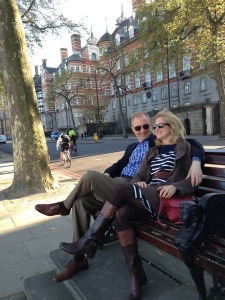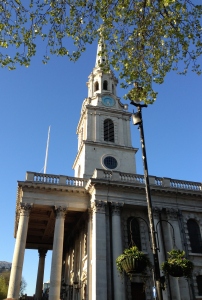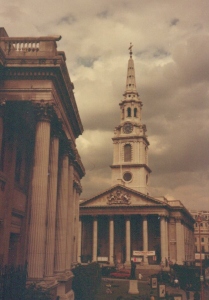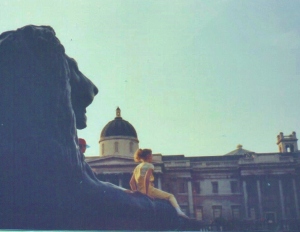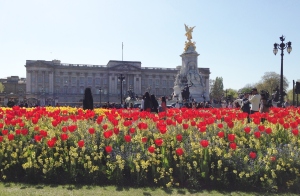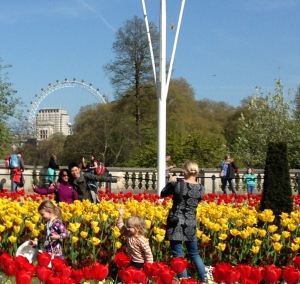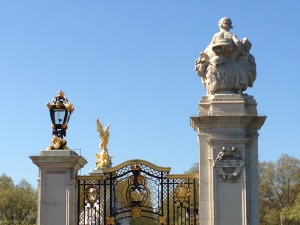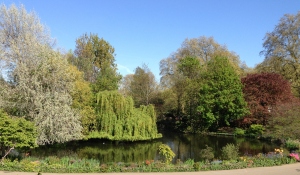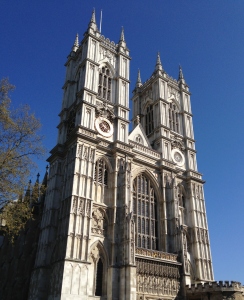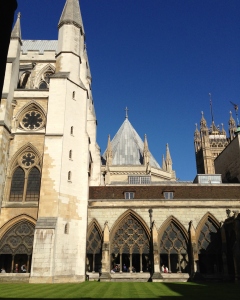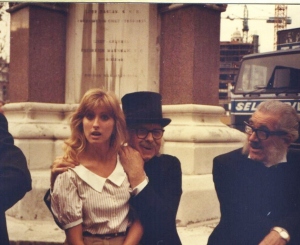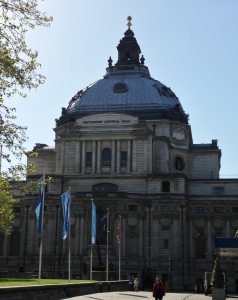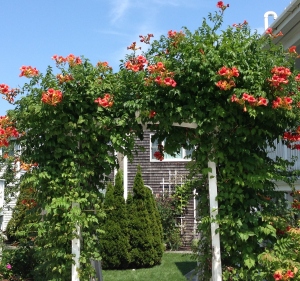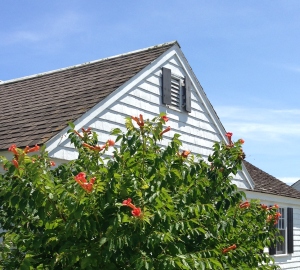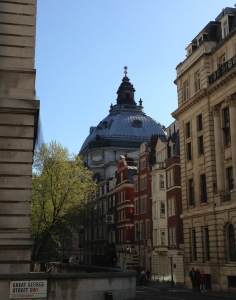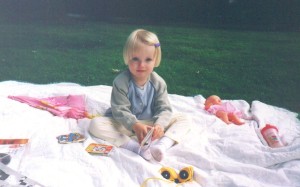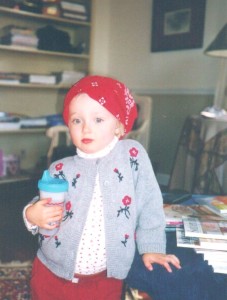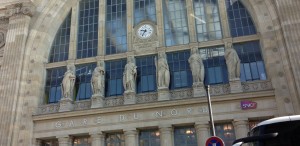Skeleton Crew
This Halloween season, our family welcomed Slim and his two charming dogs, Fluffy and Champ.
Ever the dedicated dog walker, Slim takes a load off after a neighborhood hike.
Always up for fun, the jolly trio keeps an eye out for new friends.
Slim’s musical talent is prodigious. Here he entertains with a personal favorite, Scott Joplin’s The Strenuous Life. Champ taps an appreciative paw to the ragtime beat.
Requests, anyone? He’ll be here all week. Remember to tip your servers.
A scintillating conversationalist, Slim enchants with tall tales of comedy and valor.
Be forewarned: he’s a hugger!
Slims sends this message: Happy Halloween Eve to all!
Beautiful October
I’ve been writing about springtime in London, yet all around me it’s autumn in Virginia. October, that drama queen of quickly shifting colors, skies and moods, has not disappointed. Only a scant three days remain in this most flamboyant of months. Halloween is bearing down upon us. High time, then, for a few local fall photos, reminders that nature’s beauty is near at hand.
London, Revisited, Part IV: Saint Paul’s
I was looking forward to showing my daughter Saint Paul’s Cathedral, which I’d studied repeatedly in various art history courses. D was familiar with it from her preschool years when Mary Poppins was a revered staple in our video library. In those days, I tended to remind her, too often, that the “Feed the Birds Church” was a real, famous, enormous church in London. Sometimes I’d show her pictures of it in my architecture books. And if my husband were in on the viewing, he’d explain how young Michael’s tuppence, used for bread crumbs for the birds, instead of deposited into Mr. Banks’ bank could, in theory, have caused a run on the bank. No doubt D would have preferred fewer teachable moments while she watched her movie, but that’s a burden some only children must bear.
St. Paul’s stands atop Ludgate Hill, the highest point in London. A church dedicated to St. Paul the Apostle and prolific New Testament author had existed on the spot since the sixth century. The current church replaced a large medieval basilica built in the Romanesque and Gothic styles. Like much of the City of London, it was destroyed in the Great Fire of 1666. At the time of the fire, a young Christopher Wren had been involved in updating Old St. Paul’s. A network of wooden scaffolding was in place as the stone walls were being repaired. Had the scaffolding not caught fire and ignited the wooden roof beams, portions of the medieval church might have been salvageable. After the destruction, Wren was hired to design a grand new cathedral. Wren rebuilt over fifty London churches, but St. Paul’s is his crowning glory, a masterpiece of the English Baroque style.
The highly sculptural west front of St. Paul’s, with its double temple front and twin towers.
Feed the birds, tuppence a bag.
Wren’s monumental dome drew on Italian Renaissance forerunners by Michelangelo, Brunelleschi and Bramante.
From its earliest days, St. Paul’s has been a distinctly urban church. Considering its location in the densely crowded City, the heart of London’s commercial district since ancient times, it could hardly be otherwise. Seventeenth-century images of Old St Paul’s show the hilltop basilica closely surrounded by haphazardly constructed smaller buildings. The warren of wooden homes and shops that encroached upon one another made suppressing the four-day Great Fire particularly difficult.
That St. Paul’s continues to be hemmed in on all sides by ordinary office buildings is therefore not surprising. But, I wonder, do they have to be so emphatically ugly and insinuatingly pushy? A wave of fresh disappointment hits me every time I approach the great church from a street like the one pictured above.
The British flair for the sweeping, spectacular vista is nowhere in evidence around St. Paul’s. Above, a view from the Millennium bridge.
The Millennium Bridge and St. Paul’s from across the Thames.
St. Paul’s looks down on the life of the city, as it has since its completion in 1708. Above, in Bankside near the Tate Modern, a Shrek in a silver track suit amuses pedestrians by hovering in mid-air. Despite the labyrinth of buildings that crowd the base of the Cathedral, the dome still towers well above newer, less distinguished neighbors. Let futuristic skyscrapers such as “The Shard” and “The Gherkin” continue to pop up, as long as they don’t blot out the vision of that iconic dome.
London, Revisited, Part III
As we proceeded with our walk through the heart of London, I maintained my role as a somewhat muddled and conflicted tour guide. It was with relief that I found the lacy, Gothic-style towers of Parliament and all the buildings of Westminster Palace in their expected spots, keeping watch over the Thames. Their honey-colored stone gleamed warmly in the sunlight; I had never seen them looking so pristine. The last traces of Industrial Revolution coal-dust grime were blasted away in 1994.
Although reduced in number and usage, classic examples of the red telephone box still punctuate the streets of London. That they tend to be surrounded by international tourists snapping photos with their phones strikes me as an interesting irony, further proof that our twenty-first century world is nothing if not meta.
The ever-present London Eye grew larger as we made our way down the Victoria Embankment alongside the river. Perhaps because I was distracted by the giant Ferris wheel, I completely missed one of my favorite London statues, that of the formidable Boadicea driving her chariot into battle against the Romans. Back home, when I looked for her on Google maps, I found her exactly where she should have been, on the Embankment near Westminster Pier. It was dismaying to realize I had walked blindly past the Warrior Queen.
When we paused to rest on one of the Embankment’s sphinx-armed benches, our daughter noticed that our sunglasses reflected double rings of the London Eye.
When in London, one is gifted (or afflicted), with London eyes.
From the Embankment, we approached Trafalgar Square. Since its completion in 1724, the neoclassical Church of Saint Martin-in-the Fields has anchored a corner of the square. James Gibbs’ design, with a tall, graceful steeple resembling a multi-layer wedding cake, continues to influence the building of Protestant churches throughout the U.S. I regret that we didn’t squeeze in a visit to the café in the church’s roomy, atmospheric crypt. It’s a great place to refuel and revive after wandering the halls of the National Gallery across the square.
This photo from 1982 shows the church from the steps of the National Gallery.
On the day of our visit, Trafalgar Square and the steps leading to the Gallery were awash in a teeming tide of humanity. I had hoped to show my daughter some of my favorite paintings, but the crowds made me lose heart. Spring break in London, as in Paris, has its drawbacks. It seemed futile even to try to elbow our way over to one of the grand lions that guard Lord Nelson’s column. Somewhat appropriately, in the waning afternoon light, the National Gallery takes on a grim, fortress-like aspect in the photo above.
On a less hectic day in the summer of 1982, Lord Nelson’s lions, and the Gallery itself, were more accessible.
We decided to flee the area. But a quick departure was impossible due to the press of the crowd. Had I never been in London during the week before Easter? Maybe not. During my year in the U.K., I returned home once, and that was for Easter. Maybe the city’s always as congested at this time of the season. Better to assume that’s the case than to think it’s been spoiled recently.
I know I’m not alone in occasionally wishing myself nearly alone (with a hand-picked group of family and friends) to experience the marvels of the world’s great cities. As we made our way back, slowly, toward Grosvenor Square and our hotel, I considered the advantages of conducting future British travel from the serenity of the sofa via PBS and Netflix. Under the expert guidance of, say, earnest young Endeavor Morse, or Benedict Cumberbatch’s otherworldly Sherlock, or the bright-eyed, sensibly shoed Miss Marple, one may witness matters of life and death set amidst notable U. K. monuments, without ever battling a crowd. The older I get, the more tempting that sounds.
London, Revisited, Part II
No doubt about it: I was a tourist in the city that had once been home. The experience was as unsettling as I had anticipated. Familiar buildings turned up in unexpected places. My identifications were often completely wrong. That building there–I think it’s the Horse Guards. . . What does that even mean? I used to know. Oh, it doesn’t matter–it’s not the Horse Guards at all. Too many landmarks looked different, not because of any real changes, but because of the frayed edges of memory. This is what I had feared.
Reassuringly, some sights, such as Buckingham Palace, were much as I remembered them. Its gardens of red and yellow tulips were spectacular on this bright spring day.
A major change, though, is the fact that the London Eye is visible from nearly every point in the city. I hadn’t expected it to be such a background constant.
The Victoria Memorial and the Palace Gates were as grand as ever.
St. James’s Park was dressed up in the Easter-basket colors of early spring.
Westminster Abbey hadn’t picked up and walked away. It was whiter and cleaner than I’d ever seen it before. During my first visit, in 1975, it was still blackened with nineteenth-century soot.
The lawn of the Cloister was perfectly manicured in that oh-so-British style.
During a visit in July 1982, my friends and I posed with a group of jolly actors in period costume outside the Abbey. I tried to recreate the photo with H on this trip, but the results only highlighted time’s passage, and not in a good way.
Some prominent landmarks kindled no spark of recognition. One example is this monumental building facing Westminster Abbey. It’s Methodist Central Hall, dating from 1911. As a lifelong Methodist, I’m disappointed in myself that I have no recollection of it. The headquarters of the United Methodist Church in the U.K., it serves as a conference center, concert venue and home to a large congregation with a vital and active mission. The expansive auditorium topped by its enormous dome was meant to evoke open-air camp meeting pavilions, such as that in Ocean Grove, New Jersey. Next visit, I’ll remember. Also, I’m going inside.
Year Three for WTV
It’s been three years since I began my little blog. Like the tenacious wild trumpet vine for which it’s named, it keeps on creeping on.
Wild Trumpet Vine is, for me, a convenient, inexpensive form of therapy. It’s my way of taking stock of life. It helps me keep my perspective, helps me see beyond the tedious, insistent busy-ness of daily living. It reminds me of what’s real, important, worth contemplating, worth sharing with family and friends, worth remembering, worth passing on to my daughter. Sometimes, as I sit and think and write, I discover something I should have known all along.
Occasionally, I write something that strikes a chord with another person, and I hear about it. I love it when that happens. Sometimes it’s from someone unexpected–perhaps a childhood friend I haven’t seen in thirty years or so. This is a real gift. It’s proof of the resiliency and elasticity of the ties that bind us in a web of community.
Many thanks to all my WTV readers! And many thanks for reaching out!
For more about why I write, see here.
London, Revisited
Arriving in London’s St. Pancras station after a twenty-five year absence, the first of many changes that had overtaken the city since then began to wash over me like a wave. In 1989, work on the Channel Tunnel, following decades of planning, discussion, and ongoing set-backs, was in its very early stages. Back then it was still called the “Chunnel,” and its progress, or lack thereof, was daily tabloid fodder. The media eagerly fanned the flames of unease about the possibility of a land link to the Continent opening up a deadly rabies pipeline. Enormous, rambling St. Pancras had sat largely derelict. With its brooding red-brick towers and aura of neglect, it could have been mistaken for a Victorian mental asylum. It was gratifying to see how beautifully the station had been restored and updated to accommodate the Eurostar line. Had it been in a U.S. city, it more likely would have met the wrecking ball than renovation.
Emerging onto the streets of London, a less welcome transformation confronted me. The classic, classy black cabs–those timeless Hackney carriages–where were they? I knew they still existed, in a somewhat updated form, and in colors other than black. But the streets outside the station swarmed with garish purple and orange minivans. We could have been in Cleveland. We settled for one such vehicle to take us to our hotel on Grosvenor Square. Oh well.
One thing that had not changed, however, was the near-anarchic state of London’s traffic, which tends to be particularly alarming upon first arriving. Cars, motorcycles, bicycles and pedestrians are constantly darting aggressively from unexpected directions, especially at round-abouts. About half the vehicles appear to be confused by the concept of left-side driving. Our driver was frequently outraged at the ignorance and rudeness of others on the road. Some things, then, never change. In comparison, Paris’s streets were those of a sleepy backwater.
As we made our way through the chaotic congestion, in sudden fits and stops, I caught a glimpse of the new British Library next door to St. Pancras. When I left the U.K, it had been no more than a hazy, perhaps-some-day project. Most of my daily dissertation research had taken place in the manuscript room of the old library, then part of the British Museum on Great Russell Street. Less often, I worked under the vast grand dome of the historic main reading room. The new facility, perhaps a model of sleek twenty-first century efficiency, struck me as lacking in charm.
But it didn’t matter. It’s highly unlikely that I’ll ever turn the brightly painted and gilded pages of a fourteenth-century Apocalypse again, in the new library or elsewhere. I had abandoned my academic ties, let all those bridges quietly smolder away to ashes. I’d come to the conclusion, as I was finishing my dissertation, that a career in college teaching wasn’t for me. That was fortunate, since jobs in my field were extremely rare. I have no regrets about the course my life has taken. Do I? No, I don’t.
But I do miss the chance to page through those amazing medieval books, written and illustrated by hand. Their quirky images, typically more humorous than frightening, despite the accompanying text of Revelations: the dragons that resemble perky, pointy-eared dogs sitting for treats (in my mind, now, I see Kiko in every one), and the New Jerusalem descending from heaven, looking like a Gothic princess’s dream doll house. I can point out some of the books to my daughter, although they’ll have to remain safely inside their hermetically sealed glass display cases. See this one? I studied it. I had it in front of me for an entire week. It was removed from display so I could examine it! I think she’d be impressed. Someday, I’ll show her. But probably not on this trip.
Another First Day
It’s my daughter’s first day of tenth grade. My baby is a high school sophomore. That would be hard to believe, if she didn’t look so grown up. And if she weren’t regularly driving. She got her learner’s permit at the end of June, and so far, she’s a cautious but not overly fearful driver. She’s determined not to be like me, hesitant to drive on the “big roads,” which I define as anything with an on-ramp.
Only two more such “first days,” and then she should be off to college. Now that is truly hard to believe.
As September rolls around, I get a bit nostalgic for the years when my daughter didn’t go back to school. Or for those years when school meant only preschool, three mornings a week. I like to recall crisp, sunny afternoons, when she and I had nothing more pressing to do than to wander the neighborhood in search of signs of fall. We’d collect acorns, pine cones, and brightly colored leaves. Some we used for decoration; others for crafts. (See here.) After our walk, we might spread an old quilt on the lawn and spend a couple of unhurried hours lazing there, talking, reading and snacking.
Back then, there were no hard-to-find school supplies to track down, no quandaries over which binder is better, no piles of tedious forms to complete and sign. No back-to-school nights for H and me. We’d already met the teachers. We knew them. And we had absolute confidence that if our daughter needed extra help with the curriculum, we were experts in every field of study: we knew our ABCs, we knew how to count, and how to spell our daughter’s name.
Afternoon on the lawn, September 2001.
This year, as D takes pre-calculus and chemistry, I’m glad I married someone whose intellectual strengths are my weaknesses, and vice versa. Should our daughter need assistance in math and science, my husband will be on it. I can advise on some aspects of history and English. But we’ve learned to wait to be asked. Both of us are very glad that we no longer have homework, and we have no interest in doing our daughter’s.
Thinker with a sippy cup: D in the fall of 2001.
What’s harder is not offering up certain nuggets of unsolicited advice on non-homework topics. Sometimes we know we should keep quiet because we need to let D live her life. Many situations are only made worse by our meddling in them. Other times, we realize that by saying one thing, we might prompt D to do the opposite. She’s not a rebel. But she is a teenager.
From Paris To London on Eurostar
It’s Labor Day, a time when my family confronts our many unfinished projects of the summer. No better time, then, than to resume new posts on Wild Trumpet Vine. Some, like this one, will look back to last spring, while others will be more timely. So now, back to our leaving Paris for London in April.
**********************************************************
Getting to the train and on board was by far the most stressful segment of our trip. The night before, we’d asked the hotel concierge to arrange for a taxi to the Gare du Nord at 9 AM. Our train was to depart shortly after 10. When we trooped down with our bags in tow, the friendly concierge was surprised to see us. The taxi was to arrive at 10 AM, just as we’d asked. Uh oh.
The concierge called for expedited service. A tense twenty five minutes ticked slowly by before we were on our way.
The enormous Gare du Nord was more congested and confusing than I had ever seen it. Lines for the Eurostar were snake-like and slow-moving. When at last we made it to the area leading to customs, an attendant pointed us toward a counter to fill out a boarding card. Did we each need to fill on out? He wasn’t sure. Time was short, so we completed one for the family, as I remember doing on overseas flights. Although, oddly, come to think of it, we had received no boarding cards on our Air France flight. Arriving in Paris, we had breezed through customs with barely a pause. It was like sailing through the Easy Pass lane in a New Jersey toll plaza.
Further along, another attendant asked for our boarding cards. And no. We all needed one. Didn’t we see that it said “Name” and “Passport Number”? How can that apply to an entire family? The unexpressed question being: Are you idiots? Maybe. But H and I both remembered that rather archaic wording on the cards at the airlines: To be completed by Head of Household, or something to that effect. We rushed back to grapple with the boarding cards, again. Of course, there was the typical pen problem. Those anchored to the counter (on not-quite-long-enough chains) were running out of ink. In search of working pens, I rummaged awkwardly through my purse, which was stuffed beyond full. H stared at me in exasperation. Why is he not expected to have instantaneous, magical access to some writing instrument, I wondered. Perhaps because we were in such a rush, the requested information seemed ridiculously detailed. Address in London? Are you kidding? Anyone have the hotel address? We muddled through.
We were flustered and on edge as we approached the customs agent, who sat scowling fiercely in his little glass box. Why, exactly, were we going to London? What was the purpose of our trip, he asked ominously? He grilled H and me first, then turned a laser focus on our daughter. Apparently he expected her to cave and reveal that our trip had some vile, nefarious goal. Sight-seeing? Reeaally? And what sights do you wish to see? You want to compare London and Paris? Indeed? To what end? At last the agent tired of the interrogation, and waved us on, still hostile but bored and dismissive. With relief, we made our way down to the platform, where the train was, thankfully, still waiting. It was due to depart in seven minutes.
Once on board the uncrowded train, a welcoming, quiet calm enveloped us. Whew! Only after we were settled did I look at my ticket and see, written there in bold print: Arrive at least 30 minutes prior to departure for check-in. We had completely forgotten that helpful suggestion. Because we had printed our tickets at home, the need to allot time for check-in had escaped us. Had we known how extremely close we were cutting it, we really would have been worried.
The journey from Paris Nord to London’s Saint Pancras was smooth, quick, and uneventful. We were soon served a pleasant breakfast by polite, soft-spoken attendants. In less than a half hour, we were gliding silently through the tunnel. A half hour later, we emerged into sunshine and the same gently rolling fields of brilliant gold that we had seen in France. Rapeseed, I learned, grown for its oil. An unfortunate name for something so pretty. The entire trip took about two hours and fifteen minutes. It was vastly quicker and more efficient than in the old days of train, boat and train, each segment prefaced by a long wait in a smoky departure lounge.
My family and I wouldn’t have considered adding London to our itinerary on this trip if it hadn’t been such a convenient train ride from Paris. But I was glad I lived through those old days and had the memories to show for it. Glad I had the chance, with my fellow middle-school aged friends, in 1975, to cross the Channel by slow ferry. See European Vacation, ’75: Crossing the Channel. I had described that crossing in my travel journal as a highlight of the trip. Had we traveled then on a sleek, fast train, there would have been less opportunity for adolescent adventure. While the Eurostar served my family’s purpose perfectly on this recent trip, I’m happy it didn’t exist on my very first European vacation.

